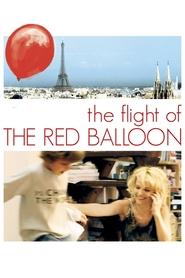These objects and people on screen don’t exist for us, no more nor less than any other objects or people in the world, and that they are on their own respective journeys in which we are passing spectators, just as they are in ours.[…]
The marginalization of the balloon conveys the film’s essential structure, in which people are in a perpetual state of movement, convening and dispersing with no overt motivation other than to live as best as they can manage. Likewise, the film itself is a red balloon, held at arm’s length, but in plain sight, inviting engagement. ['Film' plot typically] conveys meaning, but in real life, meaning may not occur to us for hours, if not years after an event. This is a cornerstone of Hou’s cinema: the understanding of a personal sense of history that arises from an ever-unfolding present.
[…]
As improbable as it sounds that the restrained Hou would channel some of the unbridled energy of Cassavetes, he nonetheless lets Binoche play rough and ready, Gena Rowlands-style.
— Kevin B. Lee (Slant Magazine)
Mr. Hou has made a film that is, to borrow a line from one of his characters, “a bit happy and a bit sad.” These words are spoken by a student who, with Simon and a cluster of others, is in the Musée d’Orsay with a teacher discussing Félix Vallotton’s 1899 painting of a child chasing a red ball, Le Ballon. Vallotton was associated with a group of Post-Impressionist artists, including Maurice Denis, who took their inspiration from Gauguin and called themselves the Nabis. The Nabis created vividly colored, abstracted images of everyday life that I think Mr. Hou must find appealing.
Embracing his status as a prophet of the modern, Denis wrote: “Remember that a painting before being a war horse, a nude woman or some anecdote or other is essentially a flat surface covered with colors arranged in a certain order.”
— Manohla Dargis (The New York Times)
Like the balloon, Song is round-faced and benign, a preternaturally calm, solitary, self-contained observer. She is also like Hou in that she, too, is a foreigner remaking The Red Balloon, albeit in DV. […] There's a relaxed interest in backstage technique—the yet-to-be-erased techie visible in Song's film, a puppeteer's hidden "dance" in Suzanne's performance, the use of the end credits as a code to the movie.
— J. Hoberman (Village Voice)
Synopsis: The first part in a new series of films produced by Musée d'Orsay, 'Flight of the Red Balloon' tells the story of a French family as seen through the eyes of a Chinese student. The film was shot in August and September 2006 on location in Paris. This is Hou Hsiao-Hsien's first Western film. It is based on the classic French short The Red Balloon directed by Albert Lamorisse.

